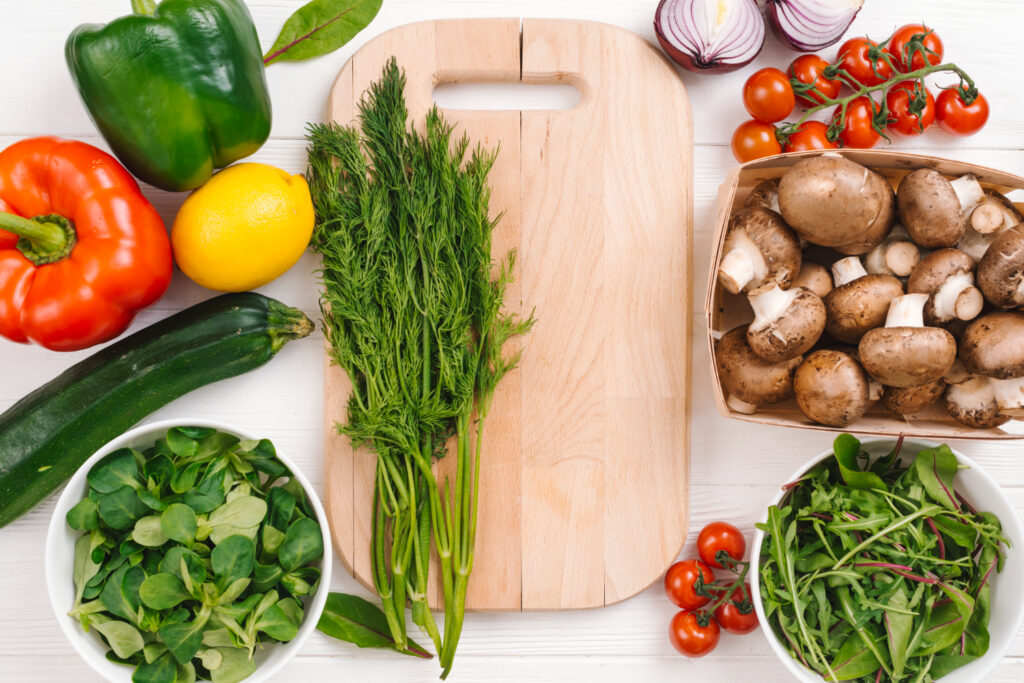
Vegetables are the cornerstone of a healthy, well-balanced diet. They’re packed with essential vitamins, minerals, fiber, and antioxidants that support overall health. These nutrients play roles in digestion, glucose metabolism, immunity, and weight management, helping to protect against disease.
The latest Dietary Guidelines for Americans recommend that adults consume 2-3 servings of vegetables daily, but more than 80% of the population falls short of that recommendation.
For those trying to increase their intake, you might wonder: which is better, raw or cooked vegetables? There’s no one-size-fits-all answer, but to maximize nutrient intake, there are times when it’s best to reach for either raw or cooked vegetables.
Benefits of Eating Raw Vegetables
Raw vegetables are rich in fiber and various micronutrients that support overall health, boost energy levels, and reduce the risk of several chronic diseases. The dietary fiber in raw vegetables supports gut health by aiding digestion and promoting regular bowel movements. These fiber-rich vegetables are also excellent sources of prebiotics, which support the growth of healthy bacteria in the gut microbiota and protect against digestive disorders.
Fiber-rich foods increase satiety between meals, supporting weight management by keeping you full longer without significantly increasing your daily calorie intake.
Raw vegetables also support immune function thanks to immune-boosting nutrients. Many vegetables are rich in vitamin C and zinc, essential for a properly functioning immune system. Deficiencies in vitamin C and zinc are closely linked with reduced innate immune response.
Consuming raw vegetables can help fight free radicals and reduce the risk of various chronic health conditions. Fresh, raw veggies are praised for their antioxidant content, which is beneficial for skin health. Bioactive compounds in raw vegetables, such as vitamin C, beta-carotene, polyphenols, and phenolic acids, can improve skin health and protect against premature aging.
Does Cooking Affect Nutritional Value?
Exposing vegetables to heat during cooking can impact their nutritional content in various ways, both positively and negatively. These effects vary between vegetable types:
- Softened fiber: Cooking can soften fiber content, making vegetables easier to digest. However, excessive cooking can significantly break down fiber, reducing gut health benefits.
- Decreased vitamin content: High temperatures and long cooking times can cause a loss of water-soluble vitamins, like B vitamins and vitamin C.
- Increased bioavailability: Cooking can enhance the availability of some nutrients, like vitamin A, by breaking down cell walls that prevent optimal absorption.
- Preserved antioxidants: Cooking some vegetables may enhance the availability of their antioxidant compounds. For example, microwaving shiitake mushrooms can increase their bioactive compounds and antioxidant activities.
Cooking vegetables alters their nutritional content and affects their health benefits. The specific effects depend on factors like cooking temperature, duration, and the type of vegetable. A well-balanced diet includes both raw and cooked vegetables to maximize dietary intake.
Which Cooking Method Is Best for Health?

There are several ways to cook vegetables, each with benefits and drawbacks:
- Boiling: Simple and requires minimal preparation, ideal for tender vegetables like potatoes, green beans, and carrots. However, boiling can lead to a loss of water-soluble nutrients like vitamin C, as essential nutrients leach into the water.
- Sautéing: Involves cooking vegetables in a small amount of oil or butter over medium heat, retaining flavor and texture. However, it requires more attention to prevent burning or overcooking.
- Roasting: Oven-roasting at high heat caramelizes natural sugars, creating a crispy texture and enhancing flavor. Excellent for root vegetables, cauliflower, and Brussels sprouts. Roasting takes more time than other methods.
- Frying: Creates a crispy texture and adds flavor but incorporates unhealthy fats and can break down heat-sensitive nutrients.
Sautéing and roasting are often favored for preserving nutritional content compared to boiling and frying. However, the best method should incorporate personal preference and overall diet. Experimenting with different techniques can help maximize nutritional value while retaining flavor and texture.
Does the Type of Vegetable Matter?
Some vegetables offer more nutritional benefits when consumed raw, while others are more beneficial when cooked:
- Raw benefits: Bell peppers retain more vitamin C, and spinach retains more folate. Other vegetables like broccoli, onions, and garlic are better eaten raw.
- Cooked benefits: Cooking breaks down cell walls, making nutrients more absorbable. For example, cooking tomatoes increases the bioavailability of the antioxidant lycopene. Cooking carrots enhances their beta-carotene content.
Choosing between raw and cooked vegetables depends on preferences and health goals. A well-balanced diet includes both to maximize nutrition and enhance the eating experience.
Is Raw or Cooked Better for Health?
There’s no one-size-fits-all diet. Nutrition is individualized, and choosing between raw or cooked vegetables depends on factors like medical history, preferences, and dietary needs. Both raw and cooked vegetables offer nutritional benefits.
Raw vegetable benefits:
- Retention of heat-sensitive nutrients
- Hydration support due to high water content
- Lower in calories and sodium
Cooked vegetable benefits:
- Improved flavor and texture
- Increased bioavailability of some nutrients, like beta-carotene
- Improved digestion due to fiber breakdown
Including both raw and cooked vegetables in a well-balanced diet maximizes nutrient intake and prevents food boredom by incorporating a variety of flavors and textures.
Tips for Consuming Vegetables
Adding vegetables to your diet doesn’t have to be a chore. Consider these tips to incorporate more veggies and maximize their nutritional value:
- Add vegetables to breakfast: Incorporate veggies into omelets, wraps, and smoothies. Spinach is a great addition to smoothies, and bell peppers and mushrooms are nutritious for egg dishes.
- Snack on vegetables: Pre-cut vegetables for easy snacks. Bell peppers, carrots, cucumbers, and celery are nutrient-dense options.
- Pair vegetables strategically: Maximize impact by pairing vegetables with other nutritious foods. For example, consume citrus fruits with spinach to absorb more iron.
- Meal prep vegetables: Wash and chop vegetables ahead of time for easy use.
- Prioritize color variety: Different vegetable colors contain different nutrients. Include a variety of colors—green, red, yellow, orange, and purple—to ensure a diverse range of nutrients.
By following these tips and including both raw and cooked vegetables in your diet, you can enjoy a well-rounded, nutritious eating plan that supports overall health and well-being











